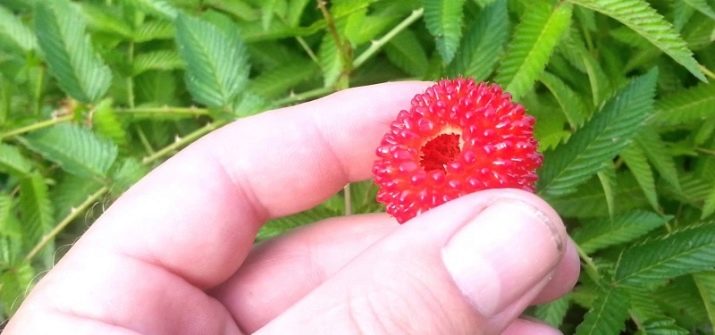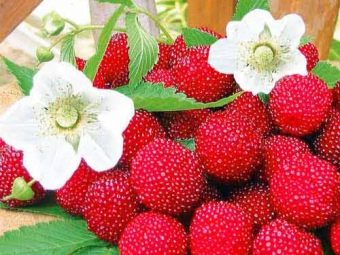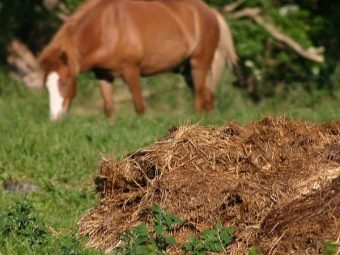Strawberry raspberry: reproduction and care

Strawberry raspberry is not yet known in all regions of our country.But many people are happy to grow this interesting raspberry variety, the berries of which taste like strawberries. For those who want to grow strawberry raspberries in their plots, reproduction and care of this unusual plant will be interesting.
Features of the plant
Compact and attractive shrub is from China, where it is grown by gardeners. In another way, this raspberry is called "Tibetan" or "Rosalyn." The berries of this particular raspberry contain large amounts of iron, like no other berry, so its benefits to the body are invaluable. According to the description, raspberry-strawberry belongs to medium-sized shrubs with a height of about one and a half meters. The flowers of the shrub are large, and in summer it is decorated with red oval-shaped berries, which have a multi-acridus structure. In the taste of the berries you can catch the notes of the dugout and blackberry. Unusually pleasant aroma is especially shown in jam or jam.
The advantages of the shrubs include a good survival rate, frost resistance and easy care. The disadvantages include intensive growth of the shrub. If it is not limited, it can take up all the space. All other disadvantages can occur only with the wrong care.
In the dry summer berries are not juicy, and sometimes they simply dry up. Therefore, the shrub must be provided with timely watering. If not treated with special chemicals, diseases can occur.
Landing nuances
When planting immediately take a certain place for raspberries and limit it. Judging by the reviews of gardeners, shrubs can fill the whole space and even supplant other cultures. So, if there are no plans to grow exclusively Tibetan raspberries, you should listen to the opinion of gardeners. In order for the plant not to occupy the whole territory, they allocate a place along the fence or limit it, digging iron, slate along the perimeter of its planting, deepening 50 centimeters. Some summer residents found an interesting feature: if you plant sorrel around raspberries, it limits its spread.
This variety, like others, loves smooth sunny areas. But according to the observation of gardeners, he feels rather well in a slightly shaded area. The main thing is that the soil is not overly swamped. For strawberry raspberries, soils with neutral acidity are more suitable, so you need to prepare the soil for planting in advance, feed it, and make good drainage. The site should be such that after the rains there does not accumulate water.
If you plan to plant a shrub in the spring, then the soil should be prepared in autumn. If planting is planned for autumn, the land needs to be prepared within a month - to make mineral and organic fertilizers.
Cuttings or seeds?
Reproduction of raspberry-strawberry is not a difficult process. It multiplies in several ways.
- The easiest way to consider the division of the bush. To do this, dig a bush and gently shears split the root. You must be very careful not to damage the root buds.
- With the help of cuttings You can also increase offspring. This is done during the growing season, cuttings must be at least ten centimeters. Some gardeners handle the lower parts of a special composition that stimulates growth. The cuttings are placed in the ground, and while they take root, you need to ensure that the soil is quite wet.
- In the second year of life, shoots appear in the bush, with the help of which it also actively propagates. Young sprouts need to dig, separate the roots from the ground and transplant to another site.
Seed propagation is the most laborious process and is not always successful. There are two options that gardeners use.
- Overripe berries are selected from which seeds are carefully removed. The berries are slightly crushed and left for several days. Then the slurry is washed, pre-laid on a sieve. This leaves seeds that need to be dried well.After the seeds have dried, they are placed in a container with the ground mixed with sand, deepening literally two millimeters. During the month, the seeds are kept in the refrigerator, after which the container is left in the room. The next three weeks should be constantly monitored to keep the ground moist. After that, after about a week, shoots should appear.
- The pips are disinfected with potassium permanganate. Then they are placed in special peat tablets. Capacity covered with foil and kept in a warm place. When the seedlings appeared, you need to wait for them to get stronger, then plant them in the prepared soil. Some place the seeds immediately in open ground, but in this case they germinate very slowly.
Water and fertilize
Summer residents who have already tried to plant this original raspberry variety, consider that caring for it is not an additional hassle. As with other berry bushes, this variety needs timely watering, fertilizing and pruning.
If these simple conditions are met, the Tibetan raspberry will delight the harvest. In watering, you need to keep the middle ground, because the plant does not like excessive moisture, and can even withstand a few days of drought. But if you forget about watering, the berries can lose their juiciness.
If it rains often, the shrub can not be watered. In the dry summer you need to water in the evening and control that the soil near the roots does not dry out. You can mulch the soil to retain moisture. The only thing to consider is conifer needles, which oxidize the soil, are not suitable for raspberries as mulch. For raspberries acidic soil to anything.
Spring shrubs necessarily need additional feeding. At the beginning of the growing season, manure or litter is calculated at a rate of one to ten. You can use dry granules of ammonium sulfate. After feeding, peat or humus is added to the bushes for greater efficiency. The second feeding in the form of potassium sulphide is produced in the fall. Nitrogen-containing fertilizers can not be made, the plant can give young shoots that will not withstand the upcoming cold weather.
The Tibetan variety of raspberry, like other varieties, does not need molding trimmings. After the summer season has come to an end and the raspberries are completely removed, all branches are cut to the ground, leaving no more than three centimeters.
In the summer shears need to remove dry, broken and those branches that do not bear fruit. Thick thickets of shrubs can not be allowed. Many gardeners say that strawberry raspberries love to grow. But too dense thickets will reduce the harvest. Near the roots, loosen the soil, remove weeds, and apply fertilizer carefully so as not to damage the young processes.
Pests and diseases
Strawberry raspberry, like other varieties, can be affected by pests, therefore it needs preventive measures. To do this, use drugs such as karbofos, detoil solution, DDT. Brodsky liquid and copper sulphate protect the plant from various diseases. If the affected branches are found, they must be removed and must be burned. Use them in the preparation of compost or mulch can not, because they can harm the plant.
The most dangerous diseases and pests for Tibetan raspberries are as follows:
- weevil, which devours leaves and flowers, leads to loss of harvest;
- the same danger is the raspberry beetle;
- if brown spots appear on the leaves, this is anthraciasis;
- the roots of young and weakened bushes can hit the root cancer;
- if the leaves turn yellow and die prematurely, this is a sign of chlorosis.
If the struggle with one of these misfortunes did not lead to success, you need to dig up the surviving specimens and transplant to a new site. Strawberry raspberry, represented by bushes aged 3–4 years old, usually hibernates well, even in conditions of the Far Eastern climate. Young seedlings gardeners harbor after shearing with agrofibre, then spruce branches. There are those who are limited to peat and humus.
As soon as spring comes, all protective coatings need to be removed, otherwise the raspberry can melt. Those who tried to plant this type of raspberry on the plot do not want to deny themselves this pleasure. Berries of unusual taste are a favorite delicacy of many.






























